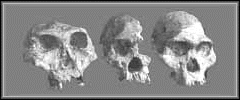
Ardipithecus ramidis,
a new species of early hominid from Ethiopia

In September, 1994, in Nature, Tim D. White and two students
named Australopithecus ramidus, a new species of early hominid.
In a corrigendum in 1995 they placed the species in a new genus, Ardipithecus.
'Ardi' means ground or floor in the Afar language. The species was
based on seventeen hominoid fossils with dental, cranial and postcranial
specimens, all from Aramis, Middle Awash, Ethiopia. Both the antiquity,
around 4.4 mya, and the primitive morphology suggest an ancestral species
for the Hominidae. Prior to this publication the earliest hominid species
was Australopithecus afarensis, dated to between 3.0 and 3.6 (possibly
3.8) mya.
A. ramidis was named in recognition of the Afar people who
contributed to fieldwork. 'Ramid' means 'root' in the Afar language.
The type, ARA-VP-6/1, an associated set of teeth from one individual,
was found by Gada Hamed in December of 1993. The specimens were collected
in 1992 and 1993. The hominid specimens were surface finds with the
immediately underlying tuff dated at 4.39 mya.
The authors distinguished the species as follows:
"upper and lower canines larger relative to the postcanine
teeth; lower first deciduous molar narrow and obliquely elongate,
with large protoconid, small and distally placed metaconid, no anterior
fovea, and small, low talonid with minimal cuspule development; temporomandibular
joint without definable articular eminence; absolutely and relatively
thinner canine and molar enamel; lower third premolar more strongly
asymmetrical, with dominant, tall buccal cusp and steep, posterolingually
directed transverse crest; upper third premolar more strongly asymmetric,
with relatively larger, taller, more dominant buccal cusp.
"A. ramidus is distinguished as a hominid ... by the following:
canine morphology more incisiform, crowns less projecting, with
relatively higher crown shoulders, cupped distal wear pattern on
lower canine; mandibular P3 with weaker mesiobuccal projection of
the crown base and without functional honing facet, modally relatively
smaller mandibular P3; modally relatively broader lower molars,
foramen magnum anteriorly placed relative to carotid foramen; hypoglossal
canal anteriorly placed relative to internal auditory meatus; carotid
foramen placed posteromedial to tympanic angle."
The dental description benefits from the ARA-VP-1/129 child's mandible
retaining a first deciduous molar. The deciduous molar has been used for
sorting apes and hominids. The Aramis deciduous molar is far closer to
a chimpanzee's than to previously described hominids. The cranial fossils
were described as evincing "a strikingly chimpanzee-like morphology."
The anterior foramen magnum distinguishes A. ramidis and infers
bipedality. This feature, together with a more incisiform canine with
reduced sexual dimorphism places this species clearly among the hominids.
The postcranial characteristics are a mosaic of hominid and great ape
characteristics.
Australopithecus was first described by Raymond Dart, after
a student brought him a fossil from a quarry. Dart contacted the quarry
manager, who sent him two crates of fossiliferous breccias. Dart noticed
a natural endocast and found the crania, a juvenile known as the Taung
child. This first Australopithecine, the type for the genus, represents
the first monumental discovery of an early hominid.
|
The Taung Child fossil, Australopithecus africanus
|

Click on images for a larger views. Photo courtesy IHO/Kimbel.
|

Sources:
White, Tim D., Gen Suwa and Berhabe Asfaw. 1994. Australopithicus
ramidis, a new species of early hominid from Aramis, Ethiopia.
Nature 371:306-312.
White, Tim D., Gen Suwa and Berhabe Asfaw. 1995. Corrigendum. Australopithicus
ramidis, a new species of early hominid from Aramis, Ethiopia. Nature
375:88.

|

![]()


